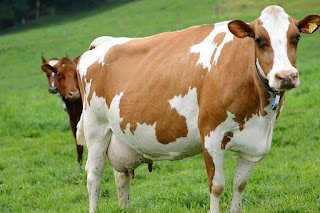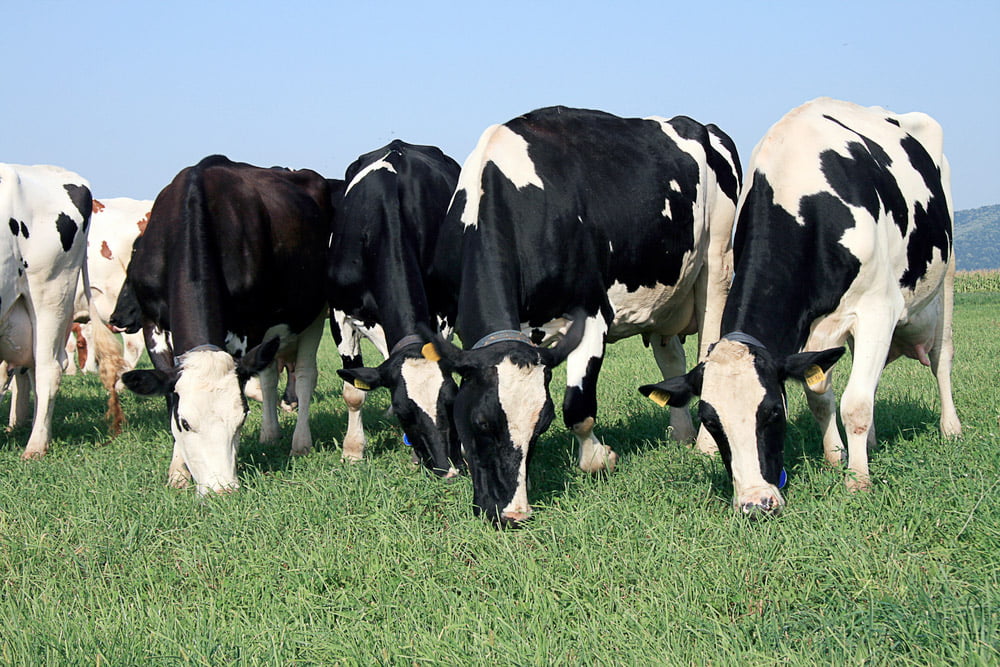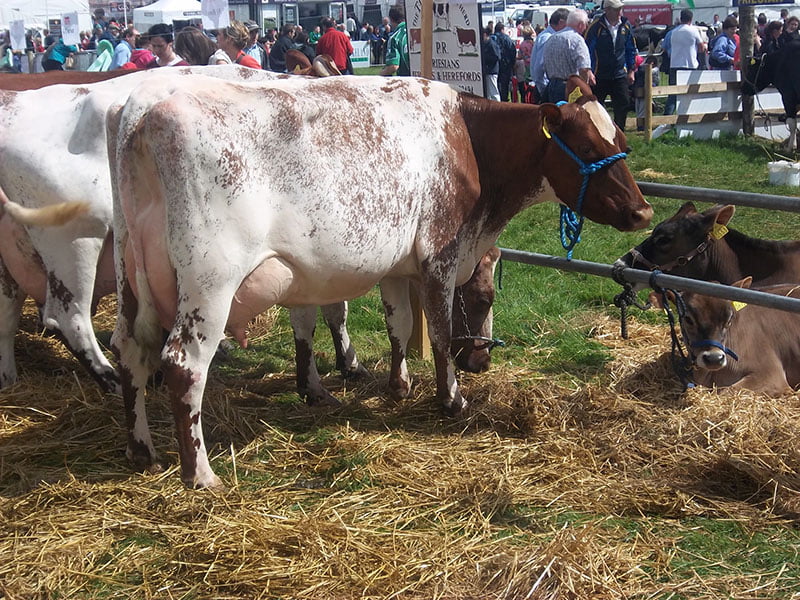This list is incomplete; you can help by expanding it.Dairy cattle are those primarily raised for their milk as part of dairy farming. Breed Country of Origin Output per Day Other Gallons Litres Ayrshire cattle Scotland 5 19 Can be used for foraging Brown Swiss Switzerland 8 30 Second largest amount of milk produced of any dairy cattle breed. Buša cattle Croatia 1 3.8 Canadienne cattle Canada 2.7 10.4 Very rare breed. Dairy Shorthorn England 7.6 29 Also called the milking shorthorn. Dexter cattle Ireland 2 7.5 Very small in size. Used in domestic farms. Guernsey…
Category: Dairy Cattle
DAIRY CATTLE FARMING (new)
The history of dairy farming dates back to the early days of human civilization. The first evidence of dairy farming can be found in the Middle East, where people were milking goats and sheep as early as 8,000 BC. Dairy farming spread to other parts of the world, including Europe, Asia, and Africa, as people migrated and traded with each other. In the early days of dairy farming, milk was consumed fresh or made into simple dairy products, such as cheese and yogurt. As technology advanced, dairy farmers began to…
Dairy Cattle breeds specialized in milk production (new)
Breeds of Dairy cow/The 4 most common cattle dairy breedsHow do you start a dairy farm?Things in your mind is probably which breed of dairy cattle to keep.The following are the most common breeds of dairy cows kept in Kenya Friesian Originated from Europe. It is white and black. Can also be red and white in colour. Low butter/ fat content. High milk production. Meat production is also high. Average live weight is 600kg. Visit via Mshindo media Guernsey Bred on the channel island of Guernsey. Brown in colour. Milk production…
Breeds of Livestock – Jersey Cattle (new)
Jersey The Jersey breed originated on the Island of Jersey, a small British island in the English Channel off the coast of France. The Jersey is one of the oldest dairy breeds, having been reported by authorities as being purebred for nearly six centuries. The breed was known in England as early as 1771 and was regarded very favorably because of its milk and butterfat production. At that early date, the cattle of Jersey island were commonly referred to as Alderney cattle although the cattle of this island were later…
TREATING MASTITIS WITHOUT ANTIBIOTICS (new) I Mshindo media
How long does it take for a cow’s udder to dry up?The average gestation period of cows varies from 275 to 283 days. To determine the drying-up date, subtract 60 days from the expected calving date. If you stop milking a cow, it will dry up. A cow with a high milk production of 20kg or more must be milked once a day during the last two to three days before drying up Mastitis is inflammation and infection of the udder. This is primarily a problem in dairy cows but can also occur in beef cows. Depending upon the infectious organism…
Dairy Cattle Breeds & management (new) I Mshindo media
Cow comfort and its effects on milk productionCertain behaviors such as eating, rumination, and lying down can be related to the health of the cow and cow comfort. These behaviors can also be related to the productivity of the cows. Likewise, stress, disease, and discomfort will have a negative effect on the productivity of the dairy cows. Therefore, it can be said that it is in the best interest of the farmer to increase eating, rumination, and lying down and decrease stress, disease, and discomfort to achieve the maximum productivity…
Abortion and Stillbirth (new)
Introduction A very common cause of abortion is Brucellosis, which can also infect humans. Brucellosis is an infectious disease caused by the Brucella bacteria. There are many other infectious abortions. But most labs in the country/region routinely only diagnose few causes of abortion other than Brucella (e.g. caused by bacteria or parasites such as Campylobacter, Trichomonas). However, close observation and submitting a full history together with the samples will help alert the lab on the possible involvement of other abortion agents (e.g. Rift Valley Fever). An abortion is referred to as an elective or voluntary abortion…
Milk | Definition, Types,Products Processing & Nutritional Value
Milk is an emulsion or colloid of butterfat globules within a water-based fluid that contains dissolved carbohydrates and protein aggregates with minerals. Dairy milk may be introduced at later ages if tolerated well. Although dairy milk may come from any mammal, cows, goats, buffalo, and sheep are common producers. Clean milk production Milk is highly perishable, it easily contract diseases. It has a high protein content making it a suitable medium for bacteria growth. For these reasons clean milk production practices are inevitable. It is advisable that farmers observe the following areas…
Cattle : Definition, Meaning, Description &Breeding
Introduction Cattle defined as domesticated quadrupeds held as property or raised for use specifically : bovine animals on a farm or ranch Cattle are raised to produce beef, veal, and dairy products Cattle (Bos indicus and B. taurus) are the most common and widespread species of large ruminant livestock and are raised primarily to produce milk, meat and hides and to provide draft power. A breed is a race or variety related by descent and similarity in certain distinguishable characteristics. More than 250 breeds of cattle are recognized throughout the World. In Africa there are…
Milk fever in dairy cows:Strategies for preventing& It’s Measures
Milk fever Milk fever arises when cows are unable to mobilise sufficient calcium at calving. This website is intended to provide a better understanding of the challenge of controlling (sub)clinical milk fever for dairy farmers. What is milk fever? Milk fever, or hypocalcemia, is a calcium deficiency. The disease has a clinical and a subclinical form and affects when cows they are at their most vulnerable – during the transition period. Cows need a large amount of calcium immediately after calving: initially they take the calcium from their blood and…
Milk fever in cows – Causes,symptoms&Control/prevent
Milk fever in cows Milk fever (hypocalcaemia) as a nutritional disorder defined as a metabolic disorder due to insufficient calcium, commonly occurring during calving,this happens when the dairy cow has lowered levels of blood calcium. • This disease occurs shortly after the cow gives birth (< 72 hrs). • The word “MILK FEVER” has nothing to do with the cause of the disease itself. • The cause of the problem is the lack of Calcium minerals in the body of the mother cow – HYPOCALCAEMIA OTHER SYMPTOMS ARE:- – Stop…
Dairy Cow Farming -About dairy cows Housing and Characteristics
Cows are livestock that are highly trusted by the majority of citizens in this country. Dairy cattle (also called dairy cows) are cattle bred for the ability to produce large quantities of milk, from which dairy products are made. There are three types of cattle raised in this country which are modern cattle, local cattle, and wild cattle. The following are the benefits of cattle breeding Food such as milk and meat Fertilizer Leather that is used as raw material to make shoes, belts, bags, clothes and beds Earning money is also…
The best dairy cow stall/Housing
Cow Shed This is a place for cows to rest and sleep at night. Each cow has its place in the resting area, it is called . Metals must be covered and the roof is made of corrugated iron, grass or thatch. The roof must be high enough so that it cannot be eaten by cows if it is made of grass or hay is stored under it. The rooms must be built in such a way that the cow remains clean all the time. Cow shed interior Clean the…













